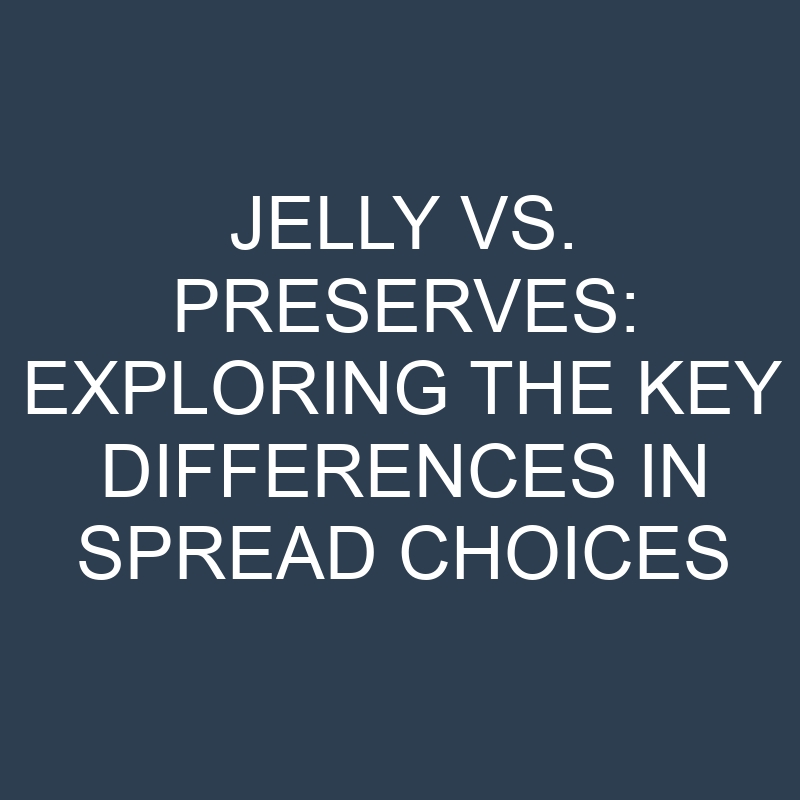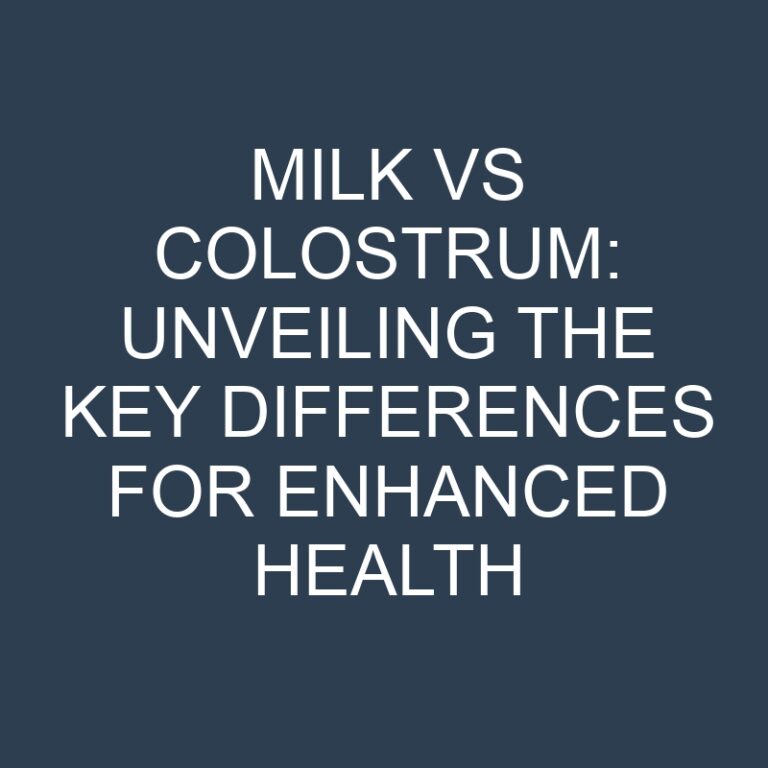
When it comes to spreads, the options can be overwhelming. Have you ever wondered about the difference between jelly and preserves? I’ll break it down for you in this article.
Jelly and preserves may seem similar, but there are key distinctions that set them apart. Understanding these differences can help you choose the perfect spread for your toast or PB&J sandwich.
In this article, I’ll delve into the unique characteristics of jelly and preserves, from their ingredients to their textures. By the end, you’ll be a spread connoisseur, ready to make an informed choice for your next breakfast or snack.
Post Contents
Key Takeaways
- Jelly is made from fruit juice, sugar, and pectin, resulting in a smooth and firm texture with no fruit pieces.
- Preserves contain fruit pieces or whole fruits cooked with sugar and pectin, offering a chunkier texture and more intense fruit flavor.
- Jelly is clear and gel-like, perfect for spreading on toast or using in baking recipes.
- Preserves have a rustic appearance due to the presence of fruit pieces, making them versatile for various uses including topping desserts.
- The choice between jelly and preserves boils down to personal preference, with jelly offering a smooth texture and preserves providing texture contrast and a more robust fruit flavor.
- Consider the fruit content and desired sensory experience when selecting between jelly for a clear consistency or preserves for a chunkier, fruit-filled spread.
What is Jelly?
Jelly is a popular fruit spread made from fruit juice, sugar, and pectin. It has a smooth and firm texture, often translucent, with no fruit pieces in it. This type of spread is clear and gel-like, usually spreadable and easy to use.
- Key Characteristics of Jelly:
- Made from fruit juice
- Smooth and firm texture
- Translucent appearance
- No fruit pieces
- Common Uses of Jelly:
- Spread on toast
- Paired with peanut butter for a classic sandwich
- Used in baking recipes for flavor enhancement
When it comes to jelly, the flavor options are diverse, ranging from classic grape and strawberry to exotic choices like guava and jalapeno. Its versatility makes it a staple in many households, offering a quick and tasty addition to various dishes.
What is Preserves?
Preserves are similar to jelly, but they have a chunkier texture due to the inclusion of fruit chunks or whole fruits. They are made by cooking fruit with sugar, often with added pectin for thickening. The result is a spread that contains identifiable pieces of fruit, providing a contrast in texture to the smooth consistency of jelly.
The pieces of fruit in preserves give them a more robust flavor compared to jelly. When you spread preserves on your toast, you’ll get a delightful burst of fruitiness in every bite. This makes preserves a popular choice for those who enjoy a more fruit-forward taste in their spreads.
Unlike jelly, preserves are often less transparent due to the presence of fruit pieces, giving them a visually appealing and rustic look. They come in a variety of flavors, from classic options like strawberry and apricot to more unique combinations like peach and ginger or blueberry and lavender.
Preserves are versatile and can be used in a variety of ways, such as spreading on bread or crackers, topping desserts like cheesecakes or ice cream, or even incorporating them into savory dishes for a sweet and savory twist.
Preserves offer a delightful combination of intense fruit flavor and textural contrasts, making them a wonderful addition to any pantry.
Ingredients Comparison
When it comes to jelly and preserves, the main difference lies in their ingredients. Let’s break it down:
- Jelly: It’s typically made from fruit juice, sugar, and pectin. The fruit juice is strained to remove any solids, resulting in a smooth and clear spread. Less fruit content means a translucent appearance and a firmer texture.
- Preserves: On the other hand, preserves are cooked with fruit chunks or whole fruits, sugar, and pectin. The presence of these fruit pieces gives preserves a chunkier texture and a more intense fruit flavor. The end result is a spread with a rustic look and a delightful contrast of textures.
In terms of ingredients, jelly is all about clarity and smoothness, while preserves embrace the richness and chunkiness of fruit pieces to offer a more robust sensory experience.
Texture Differences
When it comes to texture, the disparity between jelly and preserves becomes unmistakably apparent. Let’s delve deeper into how these delectable spreads differ in terms of mouthfeel and consistency.
- Jelly: Smooth and clear, jelly boasts a gel-like consistency due to its composition of primarily fruit juice, sugar, and pectin. Without any fruit solids to disrupt the uniformity, jelly slides effortlessly onto your toast, offering a light and delicate texture.
- Preserves: On the other hand, preserves are all about texture contrast. Packed with fruit chunks or whole fruits, preserves have a chunkier consistency, providing a delightful burst of fruitiness in every bite. The presence of these fruit pieces adds a layer of complexity and visually appealing speckles, making each spoonful a delightful surprise.
Making the Choice: Jelly or Preserves?
When faced with the choice between jelly and preserves, it ultimately comes down to personal preference and what you’re looking for in your spread. If you prefer a smooth and transparent texture that spreads effortlessly on toast or pastries, jelly is the way to go. On the other hand, if you enjoy a chunkier consistency with fruit pieces that provide a burst of flavor in each bite, preserves might be more up your alley.
One key factor to consider is the fruit content in each option. While jelly is made from fruit juice, resulting in a clear and gel-like consistency, preserves typically contain fruit chunks or even whole fruits, adding a visual appeal and textural complexity that sets them apart. For those who appreciate a more varied sensory experience, preserves offer a delightful contrast to the smoothness of jelly.
Whether you lean towards the simplicity of jelly or the richness of preserves, both spreads have their unique characteristics that can elevate your breakfast or snack time. So, the next time you’re browsing the aisles for a fruity accompaniment, consider your taste preferences and the kind of texture and flavor profile you’re craving.
Conclusion
Choosing between jelly and preserves ultimately comes down to personal taste preferences. Jelly’s smooth texture and transparency make it a popular choice for those who enjoy a spread that’s easy to spread on toast or pastries. On the other hand, preserves offer a chunkier consistency with visible fruit pieces, providing a more textured and flavorful experience. The key difference lies in the fruit content, with jelly made from fruit juice and preserves containing fruit chunks or whole fruits. Whether you prefer the smoothness of jelly or the chunkiness of preserves, both spreads offer unique qualities that can elevate your breakfast or snack time. Consider your texture and flavor preferences to find the perfect fit for your taste buds.
Frequently Asked Questions
What is the main difference between jelly and preserves?
Jelly is made from fruit juice, giving it a smooth texture, whereas preserves include fruit chunks or whole fruits, resulting in a chunkier consistency.
How should I choose between jelly and preserves?
Consider your preference for texture and fruit content. If you prefer a smoother spread, go for jelly. If you like a chunkier consistency with fruit pieces, opt for preserves.
What sets jelly and preserves apart visually?
Jelly is transparent and smooth, while preserves have a more opaque appearance due to the fruit pieces or chunks they contain.






